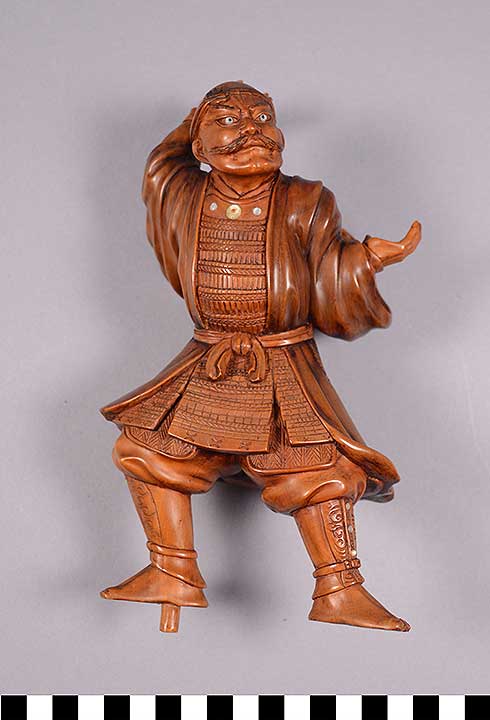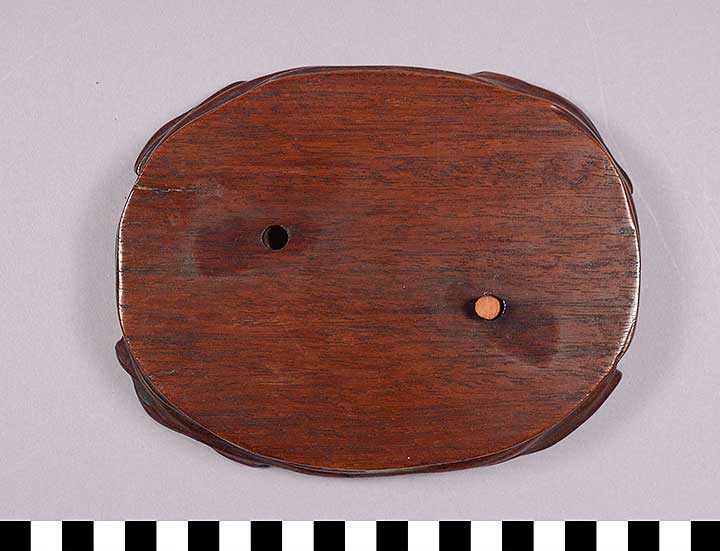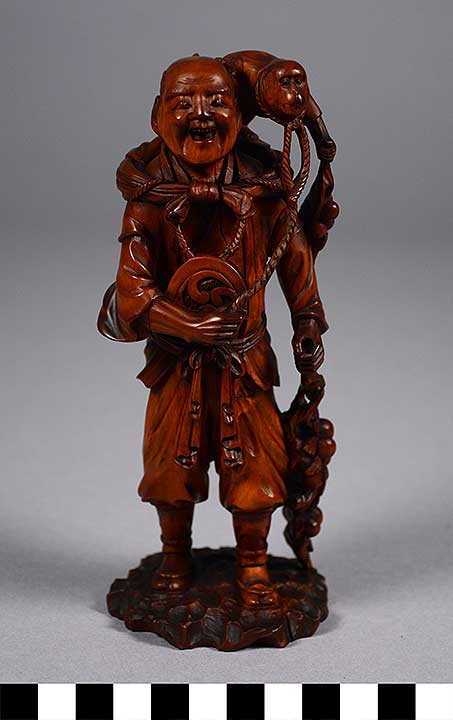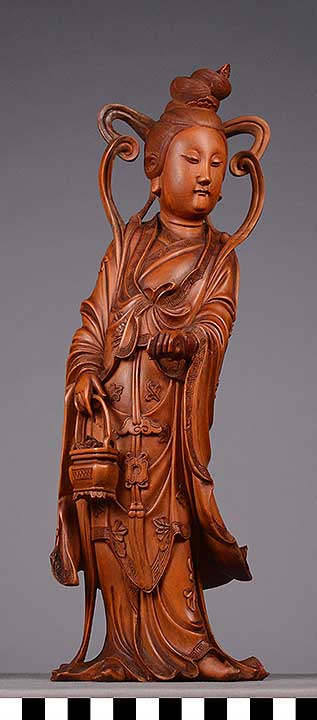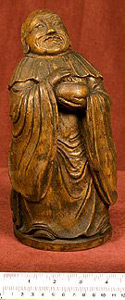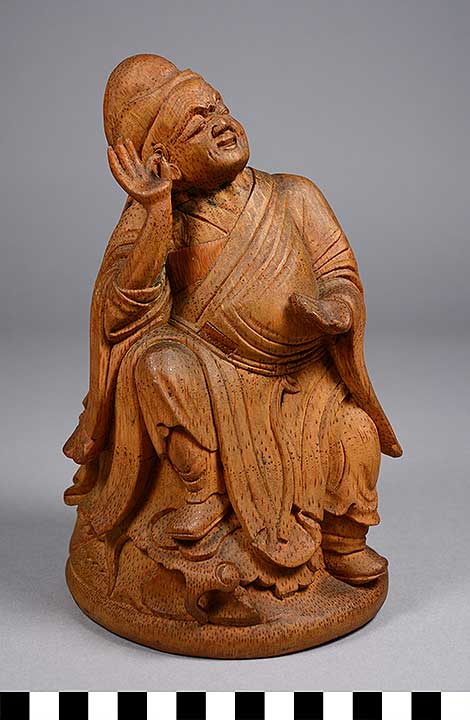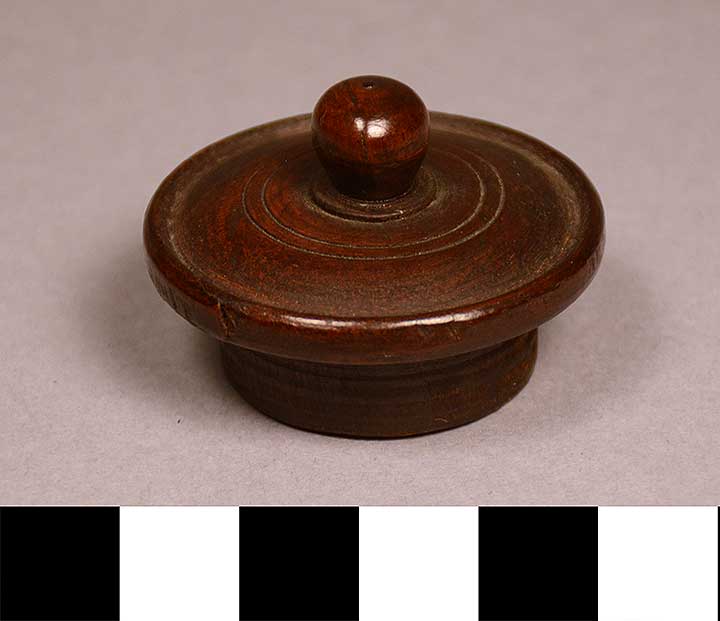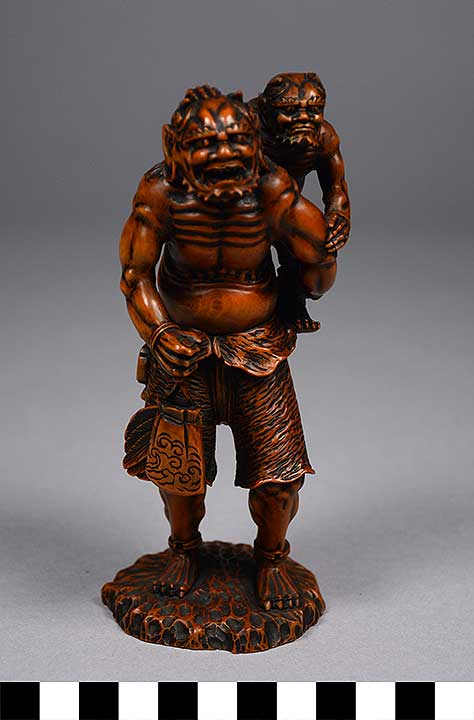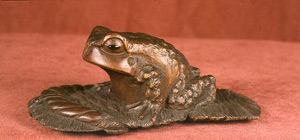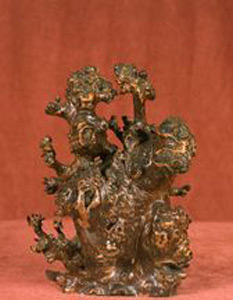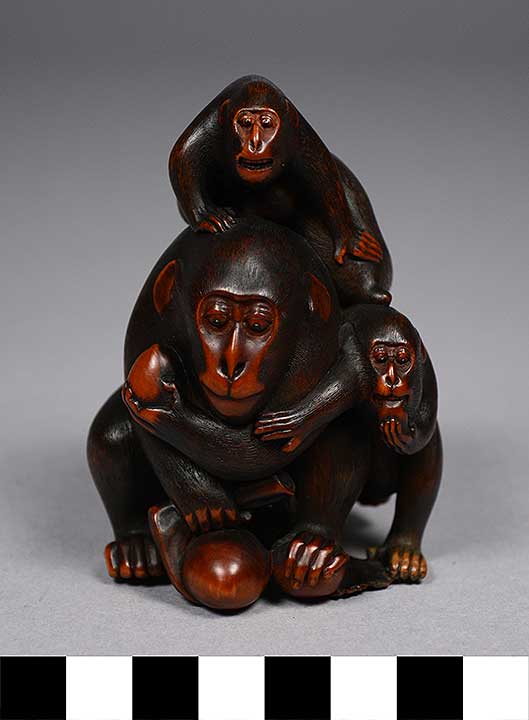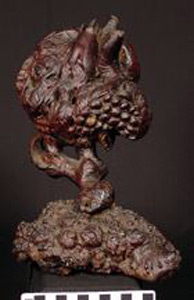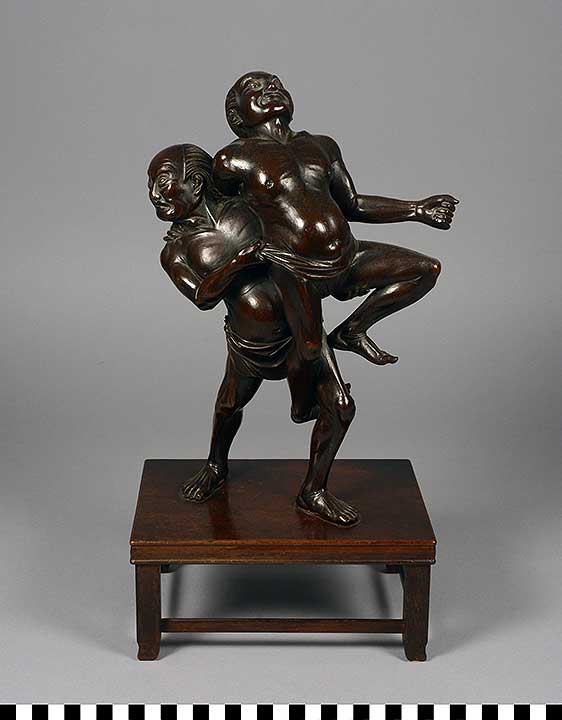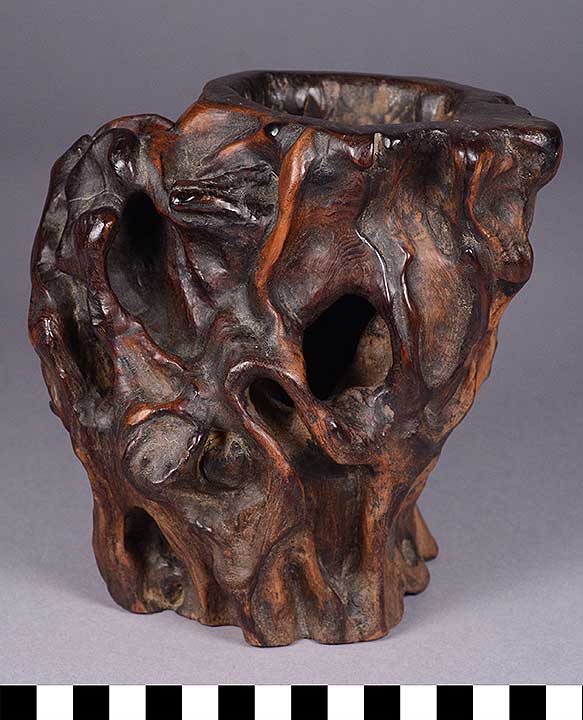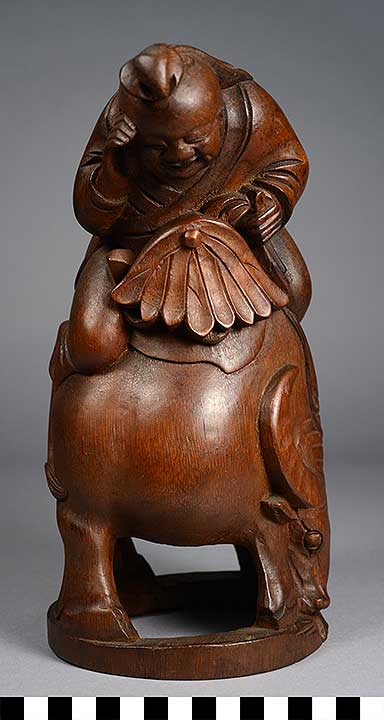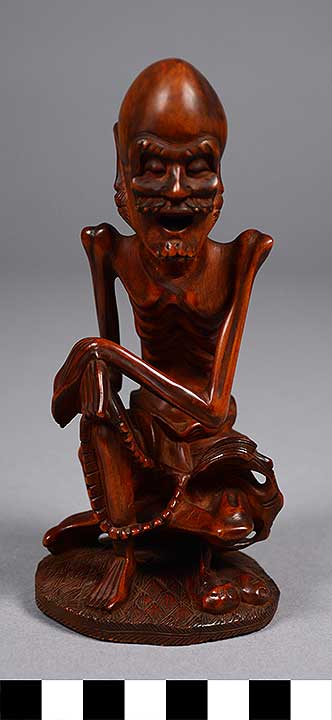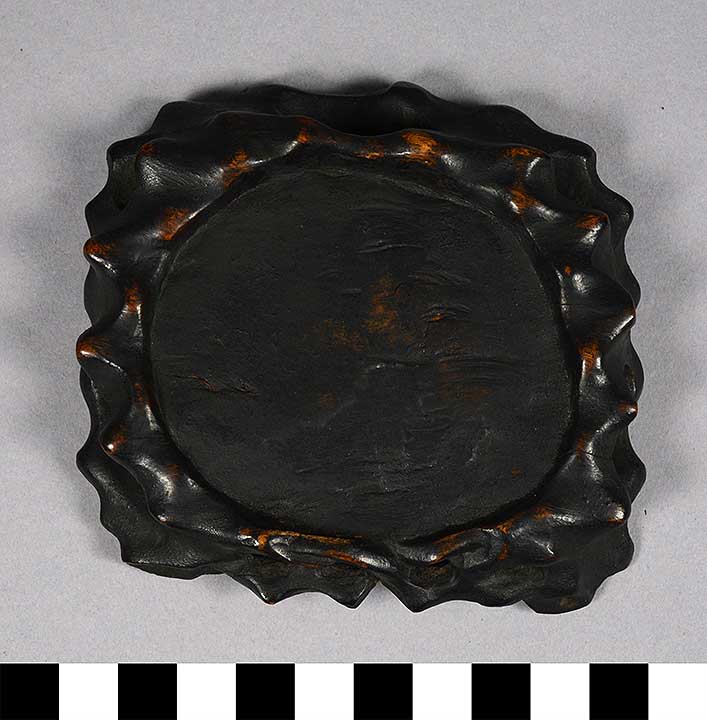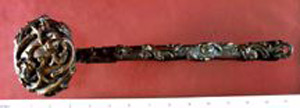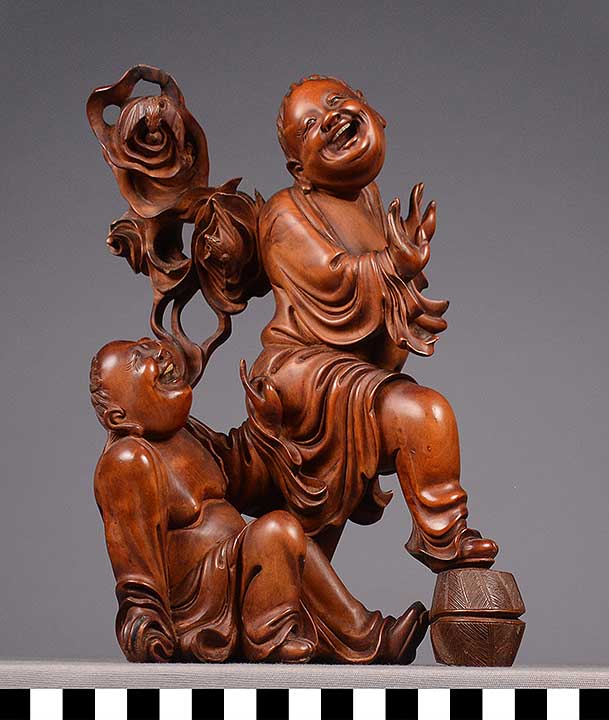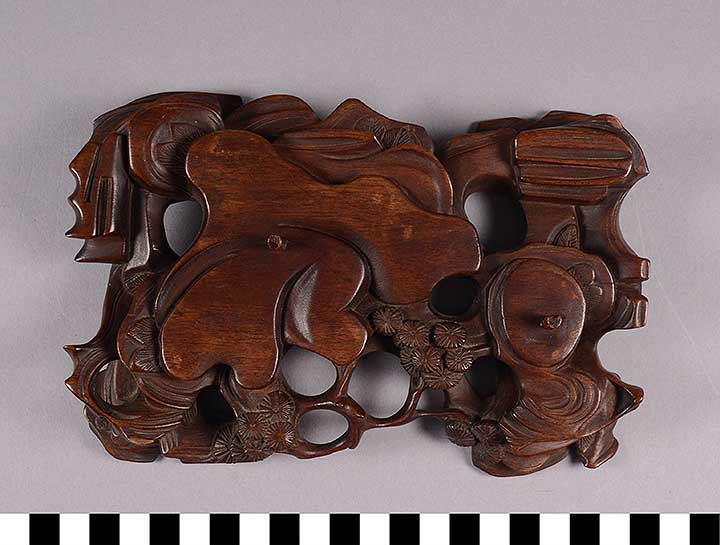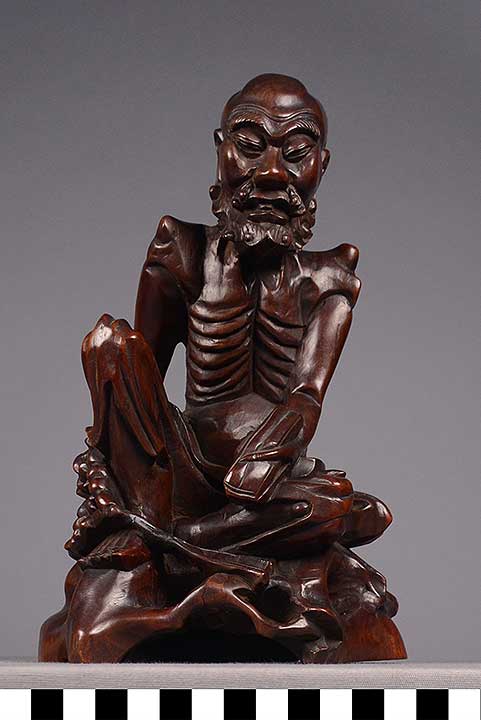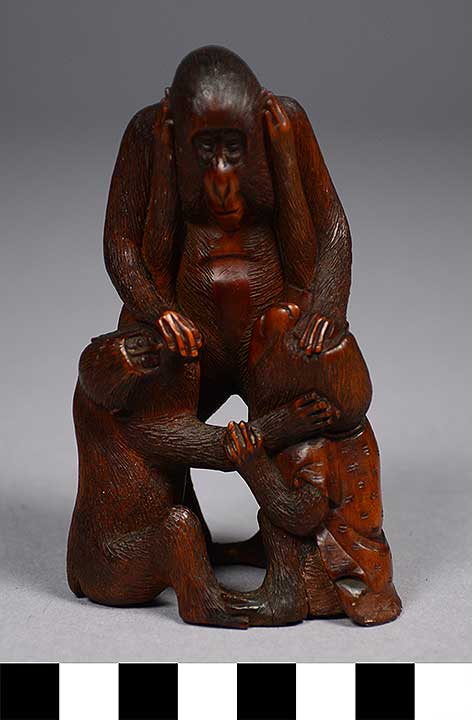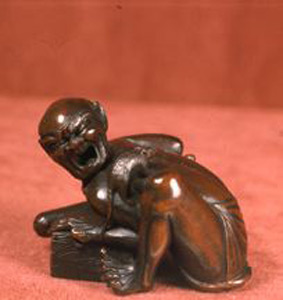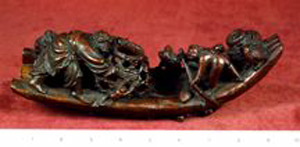Search Results - Advanced Search
Displaying Records 1 through 25 of 751 records found
with a credit line of Fred A. Freund
Okimono: Samurai1999.13.0001A (1999.13.0001A)
21 x 12.4 x 9.5 cm (310 g)
Location: Asia, East; Japan
Period: Late Meiji Period (1868-1912); 1890s – 1912 CE
Classification/Nomenclature: Communication Artifacts : Art
Description: "A Japanese boxwood okimono (a decorative sculpture) of a very detailed Samurai, late Meiji period, signed Kogetsu, 9" high, fine patina...
Period: Late Meiji Period (1868-1912); 1890s – 1912 CE
Classification/Nomenclature: Communication Artifacts : Art
Description: "A Japanese boxwood okimono (a decorative sculpture) of a very detailed Samurai, late Meiji period, signed Kogetsu, 9" high, fine patina...
Okimono Base1999.13.0001B (1999.13.0001B)
16.2 x 12.5 x 2.8 cm (329 g)
Location: Asia, East; Japan
Period: Late Meiji Period ; 1890s – late 20th century CE
Classification/Nomenclature: Communication Artifacts : Art
Period: Late Meiji Period ; 1890s – late 20th century CE
Classification/Nomenclature: Communication Artifacts : Art
Okimono: Monkey Trainer1999.13.0002 (1999.13.0002)
15.5 x 6.8 x 6.6 cm (175 g)
Location: Asia, East; Japan
Period: Late Meiji Period (1868-1912); 1890s – 1912 CE
Classification/Nomenclature: Communication Artifacts : Art
Description: "A Japanese boxwood okimono group of a monkey trainer and his monkey, late Meiji period, signed Kogetsu , 6 3/4" h...
Period: Late Meiji Period (1868-1912); 1890s – 1912 CE
Classification/Nomenclature: Communication Artifacts : Art
Description: "A Japanese boxwood okimono group of a monkey trainer and his monkey, late Meiji period, signed Kogetsu , 6 3/4" h...
Carving: Guanyin (Kannon, Kuanyin, Avalokiteshvara)1999.13.0003 (1999.13.0003)
32.9 x 12.5 x 10 cm (880 g)
Location: Asia, East; China
Period: Qing Dynasty (1644-1911); 17th – 18th century CE
Classification/Nomenclature: Communication Artifacts : Art
Description: "A Chinese boxwood carving of Guanyin (Kuan Yin), 17th/18th centiry, Qing (Ch'ing) Dynasty, 13 1/2" H...
Period: Qing Dynasty (1644-1911); 17th – 18th century CE
Classification/Nomenclature: Communication Artifacts : Art
Description: "A Chinese boxwood carving of Guanyin (Kuan Yin), 17th/18th centiry, Qing (Ch'ing) Dynasty, 13 1/2" H...
Carving: Foreigner1999.13.0004 (1999.13.0004)
21.5 x 12.2 x 11.6 cm (574 g)
Location: Asia, East; Japan
Period: Edo; 18th century
Classification/Nomenclature: Communication Artifacts : Art
Description: "A rare Japanese bamboo carving of a "foreigner", 9" H. probably Edo, 18th c., finely detailed and carved in high relief...
Period: Edo; 18th century
Classification/Nomenclature: Communication Artifacts : Art
Description: "A rare Japanese bamboo carving of a "foreigner", 9" H. probably Edo, 18th c., finely detailed and carved in high relief...
Daoist Deity (unnamed)1999.13.0005 (1999.13.0005)
21.5 x 14.5 x 12.3 cm (480 g)
Location: Asia, East; China
Period: Qing Dynasty (1644-1911); 18th century
Classification/Nomenclature: Communication Artifacts : Art
Description: "A rare and finely carved Chinese bamboo carving of a Daoist deity poking his finger into his ear, well patinated, 18th c...
Period: Qing Dynasty (1644-1911); 18th century
Classification/Nomenclature: Communication Artifacts : Art
Description: "A rare and finely carved Chinese bamboo carving of a Daoist deity poking his finger into his ear, well patinated, 18th c...
Perfume Holder1999.13.0006A (1999.13.0006A)
16.7 x 4.2 x 4.1 cm (46 g)
Location: Asia, East; China
Period: Qing Dynasty (1644-1911); 18th century
Classification/Nomenclature: Personal Artifacts : Toilet Articles : Hygiene Artifacts
Description: "A Chinese carved bamboo perfume holder, Qing Dynasty (18th century), well carved and pierced with designs of warrior on horseback in a landscape...
Period: Qing Dynasty (1644-1911); 18th century
Classification/Nomenclature: Personal Artifacts : Toilet Articles : Hygiene Artifacts
Description: "A Chinese carved bamboo perfume holder, Qing Dynasty (18th century), well carved and pierced with designs of warrior on horseback in a landscape...
Perfume Holder Lid1999.13.0006B (1999.13.0006B)
4.4 x 3 cm (18 g)
Location: Asia, East; China
Period: Qing Dynasty (1644-1911); 18th century
Classification/Nomenclature: Personal Artifacts : Toilet Articles : Hygiene Artifacts
Description: "A Chinese carved bamboo perfume holder, Qing Dynasty (18th century), well carved and pierced with designs of warrior on horseback in a landscape...
Period: Qing Dynasty (1644-1911); 18th century
Classification/Nomenclature: Personal Artifacts : Toilet Articles : Hygiene Artifacts
Description: "A Chinese carved bamboo perfume holder, Qing Dynasty (18th century), well carved and pierced with designs of warrior on horseback in a landscape...
Okimono: Raiden, Shinto God of Thunder, and Son1999.13.0007 (1999.13.0007)
15.3 x 7.7 x 6.9 cm (150 g)
Location: Asia, East; Japan
Period: Meiji Period (1868-1912); 1868 – 1912
Classification/Nomenclature: Communication Artifacts : Art
Description: "A fine Japanese boxwood okimono of Raiden, carrying his son on his shoulder, signed Kogetsu, Meiji period, 6" H...
Period: Meiji Period (1868-1912); 1868 – 1912
Classification/Nomenclature: Communication Artifacts : Art
Description: "A fine Japanese boxwood okimono of Raiden, carrying his son on his shoulder, signed Kogetsu, Meiji period, 6" H...
Okimono: Toad1999.13.0008 (1999.13.0008)
15.5 x 8.6 x 6.2 cm (131 g)
Location: Asia, East; Japan
Period: Late Edo Period (1603-1868) - Early Meiji Period (1868-1912); 19th century
Classification/Nomenclature: Communication Artifacts : Art
Description: "A Japanese boxwood okimono of a toad with inlaid eyes, 6" L, signed Masanao. Masanao Ise-Yamada was a renowned netsuke maker, who also produced okimono...
Period: Late Edo Period (1603-1868) - Early Meiji Period (1868-1912); 19th century
Classification/Nomenclature: Communication Artifacts : Art
Description: "A Japanese boxwood okimono of a toad with inlaid eyes, 6" L, signed Masanao. Masanao Ise-Yamada was a renowned netsuke maker, who also produced okimono...
Rootwood Sculpture1999.13.0009 (1999.13.0009)
17 x 12.6 x 7 cm (288 g)
Location: Asia, East; China
Period: Qing Dynasty (1644-1911); 18th - 19th century
Classification/Nomenclature: Communication Artifacts : Art
Description: "A rare Chinese rootwood sculpture of grotesque form, 18th/19th century, 7 1/2" H. Rootwood was especially appealing to scholars because of its often eccentric shapes and movements which enabled the mind to form various interpretations of its pictorial possibilities...
Period: Qing Dynasty (1644-1911); 18th - 19th century
Classification/Nomenclature: Communication Artifacts : Art
Description: "A rare Chinese rootwood sculpture of grotesque form, 18th/19th century, 7 1/2" H. Rootwood was especially appealing to scholars because of its often eccentric shapes and movements which enabled the mind to form various interpretations of its pictorial possibilities...
Okimono: Entwined Sambiki Saru (Wise Monkeys)1999.13.0010 (1999.13.0010)
7.6 x 6.6 x 6.5 cm (104 g)
Location: Asia, East; Japan
Period: Edo Period (1603-1868); Mid 19th century
Classification/Nomenclature: Communication Artifacts : Art
Description: "A Japanese boxwood okimono of entwined Saru (monkeys) with inlaid eyes (horn), signed Homin, 3 3/4" high Monkeys are of frequent occurrence in Japanese fine arts and decorative arts...
Period: Edo Period (1603-1868); Mid 19th century
Classification/Nomenclature: Communication Artifacts : Art
Description: "A Japanese boxwood okimono of entwined Saru (monkeys) with inlaid eyes (horn), signed Homin, 3 3/4" high Monkeys are of frequent occurrence in Japanese fine arts and decorative arts...
Rootwood Sculpture: Pomegranate1999.13.0011 (1999.13.0011)
22.8 x 20.8 x 16.9 cm (1063 g)
Location: Asia, East; China
Period: Qing Dynasty (1644-1911); 18th century
Classification/Nomenclature: Communication Artifacts : Art
Description: "An 18th century Chinese rootwood sculpture in grotesque form which resembles a pomegranate amidst gnarled and twisted root 10 1/2"H x 9"W...
Period: Qing Dynasty (1644-1911); 18th century
Classification/Nomenclature: Communication Artifacts : Art
Description: "An 18th century Chinese rootwood sculpture in grotesque form which resembles a pomegranate amidst gnarled and twisted root 10 1/2"H x 9"W...
Okimono: Sumo Wrestlers1999.13.0012 (1999.13.0012)
38.6 x 20.9 x 14.5 cm (984 g)
Location: Asia, East; Japan
Period: Late Edo Period (1603-1868) - Early Meiji Period (1868-1912); 19th Century
Classification/Nomenclature: Communication Artifacts : Art
Description: "A Japanese lacquered wood okimono of two Sumo (Japanese wrestlers), 16"H incl. the stand, in the intense deciding moment before the execution of the classic "Kawazu" throw...
Period: Late Edo Period (1603-1868) - Early Meiji Period (1868-1912); 19th Century
Classification/Nomenclature: Communication Artifacts : Art
Description: "A Japanese lacquered wood okimono of two Sumo (Japanese wrestlers), 16"H incl. the stand, in the intense deciding moment before the execution of the classic "Kawazu" throw...
Bitong, Brush Pot1999.13.0013 (1999.13.0013)
15.2 x 15 x 13 cm (937 g)
Location: Asia, East; China
Period: Qing Dynasty (1644-1911); 18th century
Classification/Nomenclature: Communication T&E : Written Communication T&E : Writing Accessories
Description: "A Chinese huanghuali (huang hua-li) brushpot (bitong) for the scholar's desk, 18th century, Qing (Ch'ing) Dynasty, 6"H x 6" dia...
Period: Qing Dynasty (1644-1911); 18th century
Classification/Nomenclature: Communication T&E : Written Communication T&E : Writing Accessories
Description: "A Chinese huanghuali (huang hua-li) brushpot (bitong) for the scholar's desk, 18th century, Qing (Ch'ing) Dynasty, 6"H x 6" dia...
Daoist Deity (unnamed) on Water Buffalo1999.13.0014 (1999.13.0014)
26.6 x 18.2 x 14.6 cm (778 g)
Location: Asia, East; China
Period: Qing Dynasty (1644-1911); Late 18th - 19th century
Classification/Nomenclature: Communication Artifacts : Art
Description: "A fine Chinese bamboo carving of a jovial Daoist immortal astride a water buffalo, late 18th/19th c...
Period: Qing Dynasty (1644-1911); Late 18th - 19th century
Classification/Nomenclature: Communication Artifacts : Art
Description: "A fine Chinese bamboo carving of a jovial Daoist immortal astride a water buffalo, late 18th/19th c...
Carving: Lohan (Rakan) Tama Badra1999.13.0015A (1999.13.0015A)
14 x 7.1 x 6.6 cm (136 g)
Location: Asia, East; China
Period: Qing Dynasty (1644-1911); 18th century
Classification/Nomenclature: Communication Artifacts : Art
Description: "A fine Chinese boxwood (huangyang) carving of the ascetic (Lohan - one of 500 Buddhist Disciples) Tama Badra, an emaciated skeletal figure, in seated position, 18th C...
Period: Qing Dynasty (1644-1911); 18th century
Classification/Nomenclature: Communication Artifacts : Art
Description: "A fine Chinese boxwood (huangyang) carving of the ascetic (Lohan - one of 500 Buddhist Disciples) Tama Badra, an emaciated skeletal figure, in seated position, 18th C...
Carving: Lohan (Rakan) Tama Badra, Base1999.13.0015B (1999.13.0015B)
9.7 x 9.2 x 1.9 cm (66 g)
Location: Asia, East; China
Period: Qing Dynasty (1644-1911); 18th century
Classification/Nomenclature: Furnishings : Furniture : Support Furniture
Period: Qing Dynasty (1644-1911); 18th century
Classification/Nomenclature: Furnishings : Furniture : Support Furniture
Ruyi, Scepter: Dragons1999.13.0016 (1999.13.0016)
32.1 x 9 x 6.1 cm (144 g)
Location: Asia, East; China
Period: Qing Dynasty (1644-1911); 18th century
Classification/Nomenclature: Communication Artifacts : Personal Symbols : Status Symbols
Description: "A finely patinated Chinese Ruyi (Jui) of finely carved boxwood, 18th C., 12 1/2" long. The term Ruyi is Chinese and refers to a curved scepter-like emblem of rank used in court ceremonies...
Period: Qing Dynasty (1644-1911); 18th century
Classification/Nomenclature: Communication Artifacts : Personal Symbols : Status Symbols
Description: "A finely patinated Chinese Ruyi (Jui) of finely carved boxwood, 18th C., 12 1/2" long. The term Ruyi is Chinese and refers to a curved scepter-like emblem of rank used in court ceremonies...
Carving: Hehe Erxian, Gods of Mirth, Immortals1999.13.0017A (1999.13.0017A)
20.5 x 16.3 x 9 cm (539 g)
Location: Asia, East; China
Period: Qing Dynasty (1644-1911); 18th century
Classification/Nomenclature: Communication Artifacts : Art
Description: "A very fine Chinese wood carving of two jovial Buddhist immortals, Hehe Erxian, 18th C., 10"H x 6 1/2"W...
Period: Qing Dynasty (1644-1911); 18th century
Classification/Nomenclature: Communication Artifacts : Art
Description: "A very fine Chinese wood carving of two jovial Buddhist immortals, Hehe Erxian, 18th C., 10"H x 6 1/2"W...
Carving: Hehe Erxian, Gods of Mirth, Base 1999.13.0017B (1999.13.0017B)
18.7 x 12.6 x 4.6 cm (225 g)
Location: Asia, East; China
Period: Qing Dynasty (1644-1911); 18th century
Classification/Nomenclature: Furnishings : Furniture : Support Furniture
Period: Qing Dynasty (1644-1911); 18th century
Classification/Nomenclature: Furnishings : Furniture : Support Furniture
Carving: Lohan (Rakan) Nandimitra1999.13.0018 (1999.13.0018)
21 x 14.7 x 11.4 cm (745 g)
Location: Asia, East; China
Period: Qing Dynasty (1644-1911); 18th century
Classification/Nomenclature: Communication Artifacts : Art
Description: "A fine Chinese boxwood carving of the ascetic (Lohan - one of the retinue of 500 Buddhist Disciples) Nandimitra (NAN-T' I-TO-LO-CH'ING-YU), an emaciated skeletal figure, in seated position holding a sacred book in his left hand...
Period: Qing Dynasty (1644-1911); 18th century
Classification/Nomenclature: Communication Artifacts : Art
Description: "A fine Chinese boxwood carving of the ascetic (Lohan - one of the retinue of 500 Buddhist Disciples) Nandimitra (NAN-T' I-TO-LO-CH'ING-YU), an emaciated skeletal figure, in seated position holding a sacred book in his left hand...
Okimono: Entwined Sambiki Saru (Wise Monkeys)1999.13.0019 (1999.13.0019)
9.4 x 6.5 x 5 cm (84 g)
Location: Asia, East; Japan
Period: Meiji Period (1868-1912); 1880
Classification/Nomenclature: Communication Artifacts : Art
Description: "A Japanese boxwood okimono of entwined Sambiki Saru (apes) who are the attendants of Saruta Hiko no Mikoto or Koshin, the God of the Roads, they are: Mizaru, with hands over his eyes, who sees no evil; Kinkazaru, covering his ears, who listens to no evil; and Iwazaru, his hand on his mouth, who speaks no evil, 4" high, Meiji period, c...
Period: Meiji Period (1868-1912); 1880
Classification/Nomenclature: Communication Artifacts : Art
Description: "A Japanese boxwood okimono of entwined Sambiki Saru (apes) who are the attendants of Saruta Hiko no Mikoto or Koshin, the God of the Roads, they are: Mizaru, with hands over his eyes, who sees no evil; Kinkazaru, covering his ears, who listens to no evil; and Iwazaru, his hand on his mouth, who speaks no evil, 4" high, Meiji period, c...
Okimono: Rat Catcher1999.13.0020 (1999.13.0020)
6.8 x 4.9 x 4.9 cm (45 g)
Location: Asia, East; Japan
Period: Meiji Period (1868-1912); 1868 - 1912
Classification/Nomenclature: Communication Artifacts : Art
Description: "A Japanese boxwood okimomo of the Rat Catcher, signed Masayume, Meiji period, 2 3/4" x 2". The rat is associated with Daikoku, one of the Shichi Fuku Jin (Seven household Gods, or Gods of Luck) The rat has been held to have an emblematic and moral meaning in connection with Daikoku's bag, and which like all other riches, requires constant care and watch to prevent it from dwindling away under the tooth of the parasite...
Period: Meiji Period (1868-1912); 1868 - 1912
Classification/Nomenclature: Communication Artifacts : Art
Description: "A Japanese boxwood okimomo of the Rat Catcher, signed Masayume, Meiji period, 2 3/4" x 2". The rat is associated with Daikoku, one of the Shichi Fuku Jin (Seven household Gods, or Gods of Luck) The rat has been held to have an emblematic and moral meaning in connection with Daikoku's bag, and which like all other riches, requires constant care and watch to prevent it from dwindling away under the tooth of the parasite...
Carving: Two Fishermen1999.13.0021 (1999.13.0021)
23.5 x 7.1 x 6.9 cm (188 g)
Location: Asia, East; China
Period: Qing Dynasty (1644-1911); Late 18th - 19th century
Classification/Nomenclature: Communication Artifacts : Art
Description: "A finely carved and detailed Chinses bamboo waterscape, featuring boat with fisherman, the underside uniquely carved with waves, late 18th/19th C...
Period: Qing Dynasty (1644-1911); Late 18th - 19th century
Classification/Nomenclature: Communication Artifacts : Art
Description: "A finely carved and detailed Chinses bamboo waterscape, featuring boat with fisherman, the underside uniquely carved with waves, late 18th/19th C...
Search Examples
Explore More
Access the public portions of the catalog records for the approximately 50,000 cultural and ethnographic objects in the Museum's Artifact Collection.
